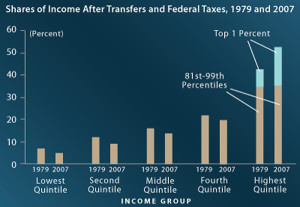The real reason that I have been delving into Census data was not to torture y’all with quizzes, but to help student journalists learn how to report on income inequality. If you want to know more about the practical steps, check out the post on the NewsNumbers.us site.
A small percentage of people at the top garner a large percentage of the income. We can measure it in different ways, but the point is that there’s a very large gap between the richest and the rest of us. That gap has been growing since the late 1970s.

Why should we care about this gap in America? Well, here are a few of the consequences:
-
Creates political and social unrest
Alienates citizens from one another and from government
Segregates neighborhoods, becomes self-perpetuating
Slows economic growth and may contribute to recession
Here’s the last quiz, I promise. The answers to it are at the end of this post, along with the answers for yesterday’s quiz on housing.
Answers for yesterday’s quiz – and like the first quiz, only a few people got even three answers correct:
-
12.5 percent of housing units in the U.S. are vacant
8.5 million are mobile homes
28.9 were built before 1960
59.9 percent have three or more bedrooms
51.8 percent of renters spend 30 percent or more of their household income on rent
The median value of owner-occupied housing is $181,200
You can view the full data profile on housing here: 2014 Housing Profile
Answers for today’s quiz:
-
4.5 percent work from home
2 percent are employed in agriculture, forestry, fishing and hunting, and mining
13.9 percent are government workers
The median household income is $53,657
21.7 percent of children in the U.S. live below the poverty line
22.9 percent of all household income goes to the top 5 percent of households
You can view the full data profile on economics here: 2014 Economics Profile
Today’s penny is a 2014, the year this data was collected.